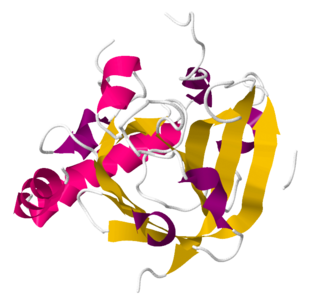Related Research Articles
Microbial collagenase is an enzyme. This enzyme catalyses the following chemical reaction

Lysins, also known as endolysins or murein hydrolases, are hydrolytic enzymes produced by bacteriophages in order to cleave the host's cell wall during the final stage of the lytic cycle. Lysins are highly evolved enzymes that are able to target one of the five bonds in peptidoglycan (murein), the main component of bacterial cell walls, which allows the release of progeny virions from the lysed cell. Cell-wall-containing Archaea are also lysed by specialized pseudomurein-cleaving lysins, while most archaeal viruses employ alternative mechanisms. Similarly, not all bacteriophages synthesize lysins: some small single-stranded DNA and RNA phages produce membrane proteins that activate the host's autolytic mechanisms such as autolysins.

Glycerol dehydrogenase (EC 1.1.1.6, also known as NAD+-linked glycerol dehydrogenase, glycerol: NAD+ 2-oxidoreductase, GDH, GlDH, GlyDH) is an enzyme in the oxidoreductase family that utilizes the NAD+ to catalyze the oxidation of glycerol to form glycerone (dihydroxyacetone).
In enzymology, a tRNA (uracil-5-)-methyltransferase is an enzyme that catalyzes the chemical reaction
In enzymology, an aspartate racemase is an enzyme that catalyzes the following chemical reaction:
Poly(3-hydroxybutyrate) depolymerase (EC 3.1.1.75, PHB depolymerase, systematic name poly[(R)-3-hydroxybutanoate] hydrolase) is an enzyme used in the degradation processes of a natural polyester poly(3-hydroxyburate). This enzyme has growing commercialization interests due to it implications in biodegradable plastic decomposition.
In enzymology, an arginine deiminase (EC 3.5.3.6) is an enzyme that catalyzes the chemical reaction
In enzymology, an O-acetylhomoserine aminocarboxypropyltransferase is an enzyme that catalyzes the chemical reaction

Neurolysin, mitochondrial is a protein that in humans is encoded by the NLN gene. It is a 78-kDa enzyme, widely distributed in mammalian tissues and found in various subcellular locations that vary with cell type. Neurolysin exemplifies the ability of neuropeptidases to target various cleavage site sequences by hydrolyzing them in vitro, and metabolism of neurotensin is the most important role of neurolysin in vivo. Neurolysin has also been implicated in pain control, blood pressure regulation, sepsis, reproduction, cancer biology pathogenesis of stroke, and glucose metabolism.

Sortase refers to a group of prokaryotic enzymes that modify surface proteins by recognizing and cleaving a carboxyl-terminal sorting signal. For most substrates of sortase enzymes, the recognition signal consists of the motif LPXTG (Leu-Pro-any-Thr-Gly), then a highly hydrophobic transmembrane sequence, followed by a cluster of basic residues such as arginine. Cleavage occurs between the Thr and Gly, with transient attachment through the Thr residue to the active site Cys residue, followed by transpeptidation that attaches the protein covalently to cell wall components. Sortases occur in almost all Gram-positive bacteria and the occasional Gram-negative bacterium or Archaea, where cell wall LPXTG-mediated decoration has not been reported. Although sortase A, the "housekeeping" sortase, typically acts on many protein targets, other forms of sortase recognize variant forms of the cleavage motif, or catalyze the assembly of pilins into pili.

Ecadotril is a neutral endopeptidase inhibitor ((NEP) EC 3.4.24.11) and determined by the presence of peptidase family M13 as a neutral endopeptidase inhibited by phosphoramidon. Ecadotril is the (S)-enantiomer of racecadotril. NEP-like enzymes include the endothelin-converting enzymes. The peptidase M13 family believed to activate or inactivate oligopeptide (pro)-hormones such as opioid peptides, neprilysin is another member of this group, in the case of the metallopeptidases and aspartic, the nucleophiles clan or family for example MA, is an activated water molecule. The peptidase domain for members of this family also contains a bacterial member and resembles that of thermolysin the predicted active site residues for members of this family and thermolysin occur in the motif HEXXH. Thermolysin complexed with the inhibitor (S)-thiorphan are isomeric thiol-containing inhibitors of endopeptidase EC 24-11 (also called "enkephalinase").

An Oligopeptidase is an enzyme that cleaves peptides but not proteins. This property is due to its structure: the active site of this enzyme is located at the end of a narrow cavity which can only be reached by peptides.
Bacterial leucyl aminopeptidase is an enzyme. This enzyme catalyses the following chemical reaction
Mycolysin is an enzyme. This enzyme catalyses the following chemical reaction
Peptidyl-Asp metalloendopeptidase is an enzyme. This enzyme catalyses the following chemical reaction
Deuterolysin is an enzyme. This enzyme catalyses the following chemical reaction
Ophiolysin is an enzyme. This enzyme catalyses the following chemical reaction
Trimerelysin II is an enzyme. This enzyme catalyses the following chemical reaction
Mucrolysin is an enzyme. This enzyme catalyses the following chemical reaction

The sedolisin family of peptidases are a family of serine proteases structurally related to the subtilisin (S8) family. Well-known members of this family include sedolisin ("pseudomonalisin") found in Pseudomonas bacteria, xanthomonalisin ("sedolisin-B"), physarolisin as well as animal tripeptidyl peptidase I. It is also known as sedolysin or serine-carboxyl peptidase. This group of enzymes contains a variation on the catalytic triad: unlike S8 which uses Ser-His-Asp, this group runs on Ser-Glu-Asp, with an additional acidic residue Asp in the oxyanion hole.
References
- ↑ Desmazeaud MJ (1974). "[General properties and specificity of action of a neutral intracellular endopeptidase from Streptococcus thermophilus]". Biochimie. 56 (9): 1173–1181. doi:10.1016/s0300-9084(74)80008-8. PMID 4451671.
- ↑ Desmazeaud MJ, Zevaco C (1976). "General properties and substrate specificity of an intracellular neutral protease from Streptococcus diaceti lactis" (PDF). Annales de Biologie Animale, Biochimie, et Biophysique. 16 (6): 851–868. doi: 10.1051/rnd:19760608 .
- ↑ Smith RA, Green J, Kopper PH (July 1980). "The purification and properties of a fibrinolytic neutral metalloendopeptidase from Streptococcus faecalis". Archives of Biochemistry and Biophysics. 202 (2): 629–638. doi:10.1016/0003-9861(80)90471-3. PMID 6779709.
- ↑ Mäkinen PL, Clewell DB, An F, Mäkinen KK (February 1989). "Purification and substrate specificity of a strongly hydrophobic extracellular metalloendopeptidase ("gelatinase") from Streptococcus faecalis (strain 0G1-10)". The Journal of Biological Chemistry. 264 (6): 3325–3334. doi: 10.1016/S0021-9258(18)94069-X . PMID 2536744.